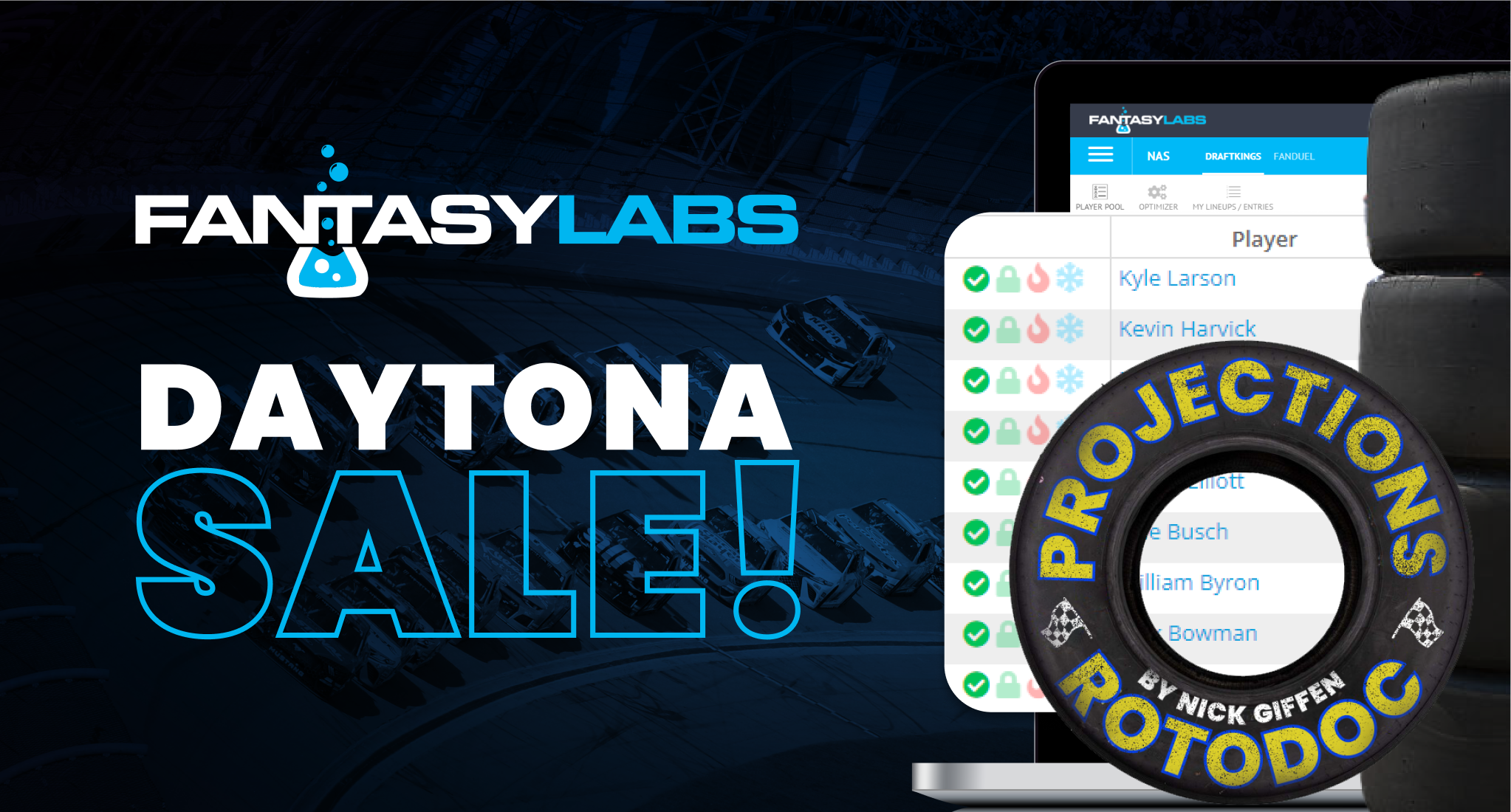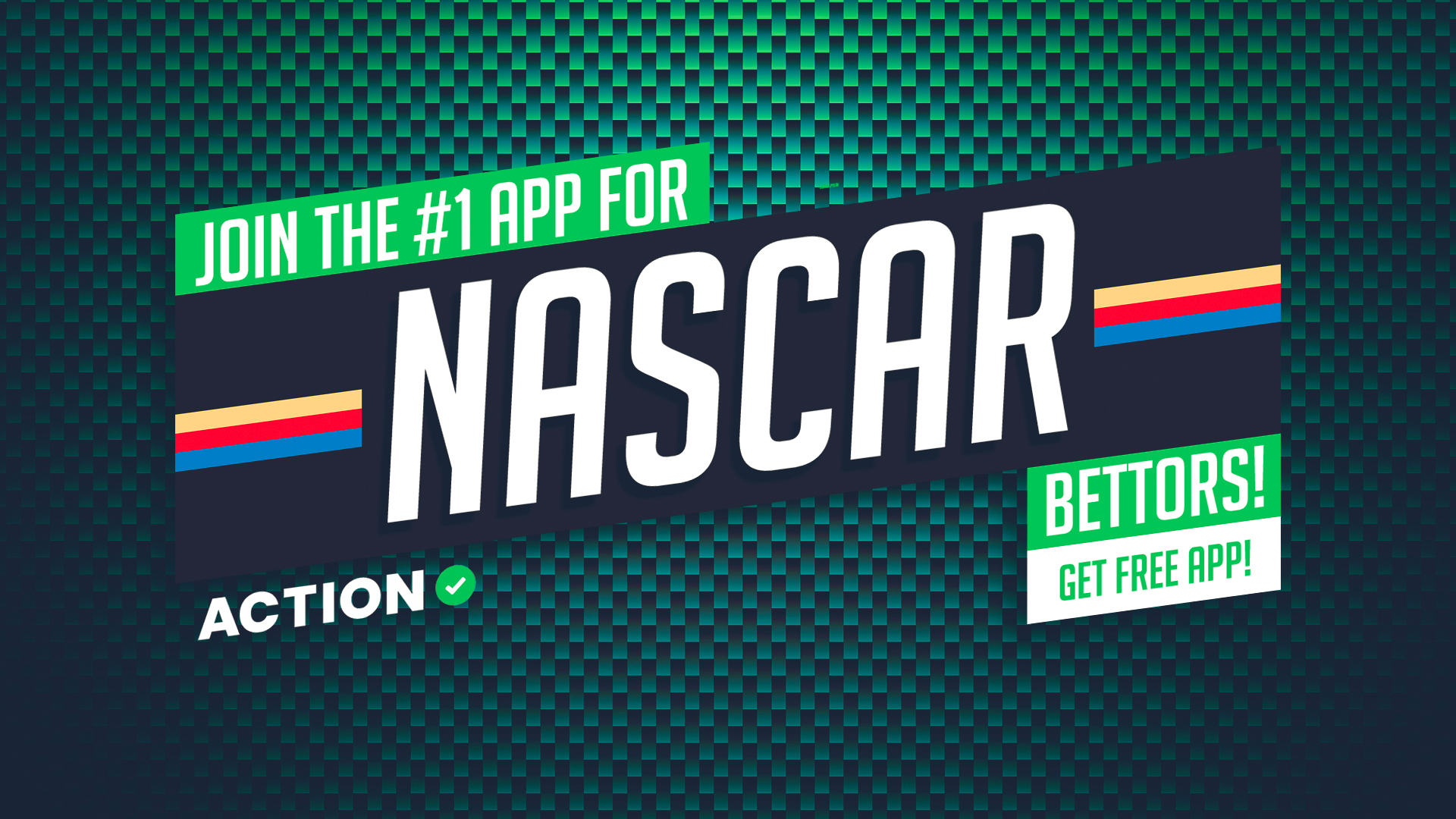The biggest race of the year goes green on Sunday! Forty drivers will take the green flag for the 2022 Daytona 500 (2:30 p.m. ET, FOX) looking to make history.
In conjunction with the Daytona 500, DraftKings has its first ever Millionaire Maker for NASCAR. That’s right, $1 million is up for grabs for posting the best six-driver lineup out of nearly 107,000 entrants.
I’m here to guide you on how to win $1 million using facts and stats based off past Daytona 500 races.
To create optimal lineups, make sure to sign up for our Daytona 500 sale today!
You’ll get access to all my projections for the Cup, XFINITY and Truck Series. You’ll then be able to use my projections in the FantasyLabs lineup optimizer!
Now that you’re ready to go with projections and the optimizer, let’s dive into the numbers!
Historical Incident Rate
Since 2005, only 54.4% of drivers have finished on the lead lap in the Daytona 500. However, in the 40-car era (since 2016) that number shrinks to 40.8%. If we only include stage racing, which started in 2017, just 33.5% of drivers complete all the laps.
This incident rate affects every driver. Even three-time Daytona 500 champion Denny Hamlin has fallen off the lead lap in 29% of his superspeedway races since 2016.
What does that mean for DFS?
First, don’t overuse drivers. If you are playing multiple lineups, no driver should be in more than 60% of your lineups.
Second, all of these incidents mean random drivers will be caught up. As those drivers fall out, other drivers who start behind them will move forward. Because DraftKings awards points for place differential, it’s imperative to have the bulk of the drivers in your lineup start in the bottom-third of the field to get the most points.
If you are playing too many drivers starting toward the front, you’ll have a bad DFS day.
Starting Position vs. DraftKings Points
Let’s look at a table of the top six DraftKings scoring drivers per race at the Daytona 500, listed in order by their starting position.
| 2016 | 2017 | 2018 | 2019 | 2020 | 2021 |
| 11 | 36 | 3 | 31 | 21 | 25 |
| 28 | 38 | 14 | 34 | 39 | 34 |
| 38 | 33 | 37 | 28 | 30 | 17 |
| 27 | 30 | 21 | 10 | 27 | 39 |
| 39 | 39 | 39 | 36 | 36 | 12 |
| 34 | 26 | 16 | 26 | 39 | 27 |
Number of drivers starting in the top five per race:
- Minimum: 0
- Maximum: 1
- Average: 0.17
Number of drivers starting in the top 10 per race:
- Minimum: 0
- Maximum: 1
- Average: 0.33
Number of drivers starting in the top 20 per race:
- Minimum: 0
- Maximum: 3
- Average: 1.17
Number of drivers starting 21-30:
- Minimum: 1
- Maximum: 3
- Average: 2.17
Number of drivers starting worse than 30th per race:
- Minimum: 2
- Maximum: 4
- Average: 2.67
Just based off averages alone, most of our drivers should be starting in the back-half of the field. It’s okay to sprinkle drivers starting inside the top 20, but you should limit yourself to at most three, and even that only happened once!
It’s even more rare to find a driver starting inside the top 10. These drivers should be used sparingly in your lineups.
Driver Salary
Another habit that most DFS players do is they tend to use most, if not all of the $50,000 salary cap DraftKings provides. This is a good tendency to have for most NASCAR races, but for the Daytona 500 you can throw that out the window.
Since 2017 when stage racing began, the the winning DraftKings lineup has averaged a salary of $45,060 with a range from $42,400 to $47,600.
The reason for this is because drivers starting in the back include a lot of the mid-tier and lower-priced options. The big draft they get from the pack lets them keep up, and even pass the top-tier drivers. If they avoid the major incidents, they can pull off top-10 finishes.
Every year, at least two drivers under $7000, and at least three drivers under $8000, were in the winning lineup. In fact, in 2018 five of the six drivers in the winning lineup were under the $8000 mark!
Daytona 500 NASCAR DFS Strategy and Rules of Thumb
Rule No. 1 — Avoid the front-row starters
Only once since 2005 has a front-row starter finished in the optimal lineup at Daytona! Even if we extend this to the top-eight DraftKings scoring drivers per race that number stays at one. So out of 34 opportunities (17 races with two front-row starters each) a front-row starter has been in the top eight at a rate less than 3%.
I don’t expect this year’s front-row drivers to end up in the optimal lineup. The Chevys of Kyle Larson and Alex Bowman have qualifying speed, but the Ford camp looked dominant in the Duels. Additionally, Larson and Bowman are not known for leading laps at superspeedways.
They have a combined 96 laps led in 46 career superspeedway starts in quality rides for an average of 2.1 per race. That includes 11 front-row starts between them where they have led only 18 laps total.
Larson and Bowman will probably combine for 15% exposure at least, so there’s at least 10% leverage on the field right there.
Rule No. 2 — Use no more than 2 top-10 starters, preferably 0 or 1
Since loop data began in 2005, there has never been an optimal lineup with more than two top-10 starters in the Daytona 500.
Additionally, the optimal had exactly two drivers starting inside the top 10 twice in 17 races. That implies, if you multi-enter, about one-eighth of your lineups should have two drivers inside the top 10.
The remaining lineups should be split between zero and one.
Rule No. 3 — Dominators rarely matter
It’s unwise to target drivers you think may accumulate “dominator” points — the points that are awarded for laps led and fastest laps.
Since 2005, only seven drivers have led at least 15% of the race (30 laps). Of those, only one of those drivers earned more than 50 DraftKings points, which is the minimum threshold you will likely need for a driver to end up in the optimal lineup.
In most races, the drivers who lead laps also accumulate a lot of fastest laps, but that’s not true at Daytona. Drivers that are in the draft will earn fastest laps thanks to the extra tow they get from the cars in front of them, allowing them to pick up speed. The driver leading laps won’t get that tow.
Rule No. 4 — Leverage your driver exposures vs. the field
The FantasyLabs projections include a stat called Perfect%, which is just the percentage of time a driver appears in the optimal lineup from 100,000 simulations from my statistical model.
The projections will also include projected ownership, so you can get an idea of exactly which drivers DFS players will have too much or too little exposure to. This way, you can leverage your lineups by coming in close to the Perfect% with your exposures.
If you want to get risky, you can even use an exploitative strategy.
An example would be this: Let’s say Hamlin is projected to be in 60% of lineups, but is going to be optimal only 45% of the time.
A theoretically optimal strategy would have 45% exposure to Hamlin. However, if you want to get risky, you can leverage the fact that Hamlin will be 15% over-played, and instead use Hamlin in less than 45% of your lineups.
In this case, if he misses getting near the optimal, which the probabilities suggest he would, then you’d be in line for a big payday!
Wrap Up
If you’re going for the $1 million dollar prize, you will need to be smart about how you do it.
Knowing the tendencies of roster construction is important. Identifying which drivers will be over- or under-played is even more important. Embracing risk is quite important. Getting lucky is extremely important.
But the most important thing of all is to enjoy the Daytona 500 and have fun! Stay within your bankroll’s means and realize this is a race with very high variance.
That way you’ll be able to enjoy the “Great American Race” to its fullest!




